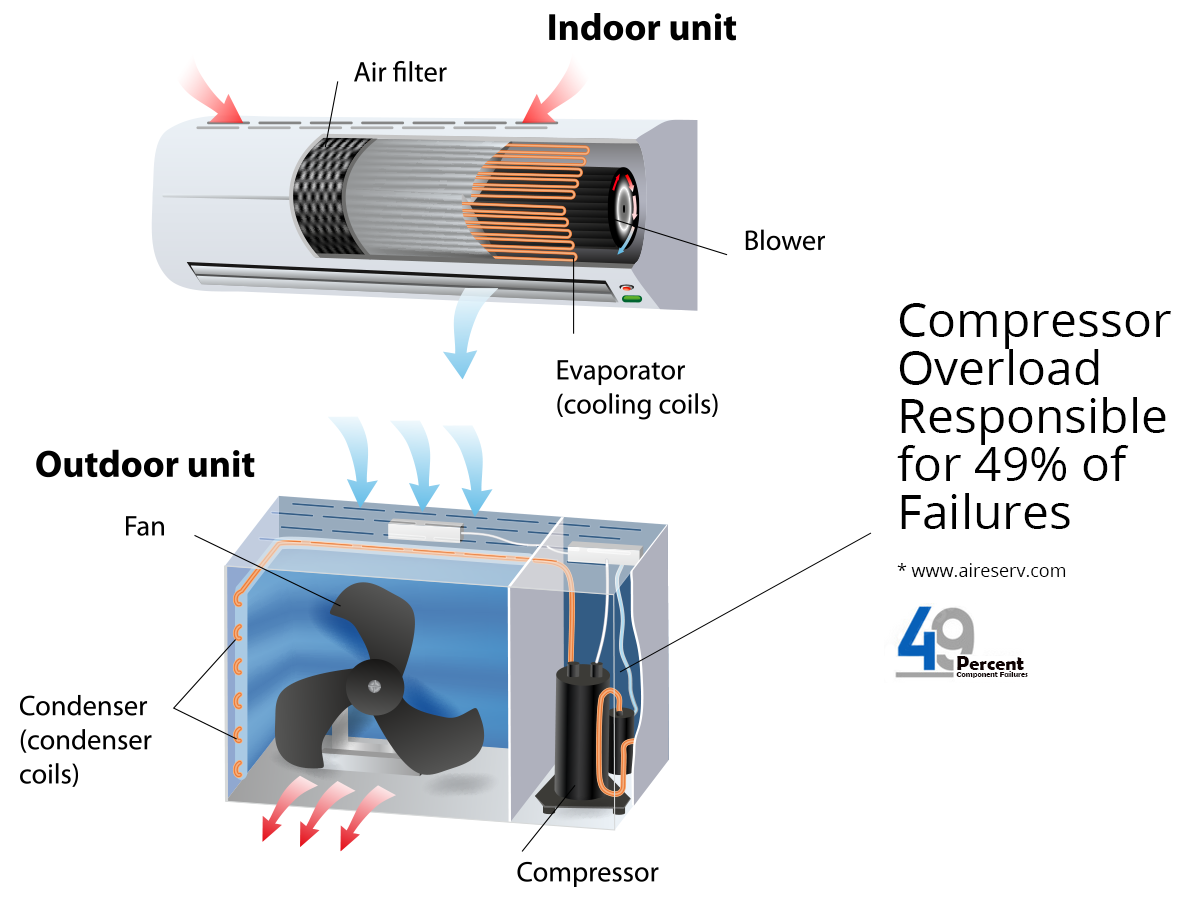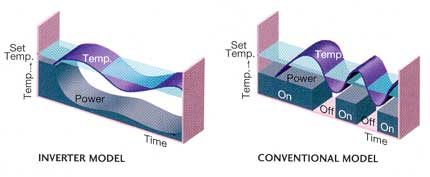Air conditioning your home can add both comfort and value
Brisbane Air Conditioning Systems
Breakdowns - How to handle an overloaded air conditioner
Cleaning air conditioners
Coefficient of performance
Cooling your house naturally
Ducted Air Conditioning Servicing
Saving Energy with Air Conditioners
Energy Used by Percentage
Electrical Work
Green House Gases and air conditioners
How does an air conditioner work?
Salt air on air conditioners
Split Systems
Temperature for efficient use of air conditioner
If you are concerned about mould and bacteria from air conditioning systems an air purifier may be helpful.

Have you ever been sitting in your home experiencing a nice moment with the air conditioning running... and the unit breaks down and your home becomes a
sweat box?
Would you like to know how to fix this
problem?
Well your air conditioner has safety
mechanisms that cut in when the coil on
the back of your outdoor condenser gets
too hot. The pressure builds up in your
system and your unit cuts off on high
head pressure.
So some simple things you can do to
help prevent this occurring are the following:
* The first thing is to make sure there is
shade over your air conditioner, while
still not restricting the airflow around
the unit.
Now, if your system still cuts out you
can get a sprinkler and spray a fine mist
over the back of your coil on the outside
unit. This will reduce the pressures in
the system and allow the system to keep
running.
This is a really handy trick when it's
very hot you have visitors and your unit cuts out.
If your unit breaks down do the following:
Just wait 20 minutes, then use your
sprinkler to spray water on the coil at the
back of your air conditioner. In most
cases this will then allow you to keep your cool!
Air conditioning installer Jeff Thatcher recommends cleaning your air conditioner for better life of the machine and your environment.
One cause of indoor air contamination is due to bacterial and fungal contamination of air filters, heat transfer coils and ductwork within air-conditioning systems that are poorly designed and maintained.
The efficiency of a refrigeration system is measured by its coefficient of performance (COP), and is normally given as the ratio of the refrigeration effect to the compressor power:
COP = (Cooling output) / (Electrical input)
For most packaged commercial cooling units the COP varies between 2.5 and 4.0. However, some modern commercial cooling units have COPs of about 5.0. As the external temperature increases the COP is progressively reduced to about 2.0 at 40°C.
There are many techniques that can help cool your home naturally. Check your use of appliances according to this article on cooling your house naturally an incandescent light bulb emits up to 90% of its energy as heat.
Keep your windows shaded preventing direct sunlight into your house. Avoid warm air from coming in from outside.
Use deciduous trees to allow light in winter and shade in summer.
Ducted Air Conditioners benefit from being serviced as like any piece of equipment of machinery.
Refer to the article about Servicing Ducted Air Conditioners
There are some simple things you can do to save energy when using an air conditioner:
Awnings for Windows
Installing awnings on your windows can dramatically cut down on the glass house effect of windows. Gold Coast Awnings has a set of installation recommendations to cut down on the strong summer sun.
Air conditioning systems use roughly 11% of the energy used in US buildings, and are the main contributors to peak demand in summer months leading to brown-outs and black-outs of the electric grid.
Air conditioning systems by law need to be installed properly by a licensed electrician. Depending on the location and local laws any electrical equipment over a certain amp level may need an electrician. Having an air conditioning installer who is also a qualified electrician makes sense.
The air-conditioning and refrigeration industry is the largest user of hydrofluorocarbons (HFCs), a group of potent synthetic greenhouse gases, and is a significant user of energy. Refrigeration and air conditioning equipment that is not maintained in good order consumes more energy than necessary thus increasing the amount of CO2 released to the atmosphere.
Air conditioners and refrigerators work the same way. Instead of cooling just the small, insulated space inside of a refrigerator, an air conditioner cools a room, a whole house, or an entire business.
Air conditioners use chemicals that easily convert from a gas to a liquid and back again. This chemical is used to transfer heat from the air inside of a home to the outside air.
The machine has three main parts. They are a compressor, a condenser and an evaporator. The compressor and condenser are usually located on the outside air portion of the air conditioner. The evaporator is located on the inside the house, sometimes as part of a furnace. That's the part that heats your house.
The working fluid arrives at the compressor as a cool, low-pressure gas. The compressor squeezes the fluid. This packs the molecule of the fluid closer together. The closer the molecules are together, the high its energy and its temperature.
The working fluid leaves the compressor as a hot, high pressure gas and flows into the condenser. If you looked at the air conditioner part outside a house, look for the part that has metal fins all around. The fins act just like a radiator in a car and helps the heat go away, or dissipate, more quickly.
When the working fluid leaves the condenser, its temperature is much cooler and it has changed from a gas to a liquid under high pressure. The liquid goes into the evaporator through a very tiny, narrow hole. On the other side, the liquid's pressure drops. When it does it begins to evaporate into a gas.
As the liquid changes to gas and evaporates, it extracts heat from the air around it. The heat in the air is needed to separate the molecules of the fluid from a liquid to a gas.
The evaporator also has metal fins to help in exchange the thermal energy with the surrounding air.
By the time the working fluid leaves the evaporator, it is a cool, low pressure gas. It then returns to the compressor to begin its trip all over again.
Connected to the evaporator is a fan that circulates the air inside the house to blow across the evaporator fins. Hot air is lighter than cold air, so the hot air in the room rises to the top of a room.
There is a vent there where air is sucked into the air conditioner and goes down ducts. The hot air is used to cool the gas in the evaporator. As the heat is removed from the air, the air is cooled. It is then blown into the house through other ducts usually at the floor level.
This continues over and over and over until the room reaches the temperature you want the room cooled to. The thermostat senses that the temperature has reached the right setting and turns off the air conditioner. As the room warms up, the thermostat turns the air conditioner back on until the room reaches the temperature.
To install an air conditioner for example a split system Fujitsu, you need a qualified air conditioning installer. Some companies like Fujitsu recommend installers or have conditions that if your system is not installed to their requirements your warranty is void.
Air Conditioner Installations Australia is a site where you can find an air conditioning installer with the skills to install an air conditioner properly.
What comes with a split system (for installation)
Normally - your split system air conditioner comes with everything that is required for installation except for interconnect wiring and copper pipes although it is fairly common practice for installers to supply these items.
The cost of installing a split system air conditioner in Australia starts at around $500 plus may require electrical wiring up to $250. Based on this it is sometimes a benefit to use an installer to arrange everything.
In 1902, only one year after Willis Haviland Carrier graduated from Cornell University with a Masters in Engineering, the first air (temperature and humidity) conditioning was in operation, making one Brooklyn printing plant owner very happy.
Fluctuations in heat and humidity in his plant had caused the dimensions of the printing paper to keep altering slightly, enough to ensure a misalignment of the coloured inks. The new air conditioning machine created a stable environment and aligned four-colour printing became possible. All thanks to the new employee at the Buffalo Forge Company, who started on a salary of only $10.00 per week.
...
Cooling for human comfort, rather than industrial need, began in 1924, noted by the three Carrier centrifugal chillers installed in the J.L. Hudson Department Store in Detroit, Michigan. Shoppers flocked to the 'air conditioned' store. The boom in human cooling spread from the department stores to the movie theatres, most notably the Rivoli theatre in New York, whose summer film business skyrocketed when it heavily advertised the cool comfort. Demand increased for smaller units and the Carrier Company obliged.
Through new, advanced technology, Inverter air conditioners are more economical to operate and quieter to run than conventional units. They can handle greater extremes in temperature, are smoother and more stable in operation, and reach the desired temperature more quickly than conventional air conditioners.

A noisy air conditioner can making getting a good night sleep difficult. Check this video about a noisy air conditioner
Setting up outdoor units can be counter intuitive. Check with your manufacturer. Brisbane air conditioning provider Jeff Thatcher recommends certain techniques to reduce vibration. Even the Fujitsu manual suggests not to attach the air conditioner to the ground - it suggests a strong stand e.g. one made of concrete blocks to minimise shock and vibration.
Jeff Thatcher recommends applying a lubricant to your air conditioner almost weekly in areas close to the beach.
He also has some solutions that can help prolong the life of your system.
Jeff a keen surfer has adapted some techniques recommended by JetSki mechanics to keep a system going that is exposed to salt water.
Split systems are where the compressor and outdoor heat exchanger are located outside, some distance from the indoor air-handling unit. They are joined together by refrigerant lines. You need to get the Systems installed by a professional installer.
The indoor units can be floor mounted, wall mounting, ceiling mounting or as cassette units. Outdoor units are usually located externally on the roof, on a balcony or at ground level.
The Queensland government (Australia) promotes 24 degrees Celsius as being the recommended temperature for the efficient use of an air conditioner when cooling.
This is supposedly a temperature that keeps you comfortable and does not use undue
power to the unit.
What is covered in an Air Conditioning Warranty?
Daikin & Fujitsu Air Conditioning Equipment Warranty-:
Air conditioning equipment comes with a full 5 years parts and labour warranty from the manufacturer.
Ducting, outlets and fittings come with a 10 year manufacturers parts warranty.
Check your supplier is authorised to install your air conditioning system. Having read some Fujitsu warranties they can be very specific about installations.